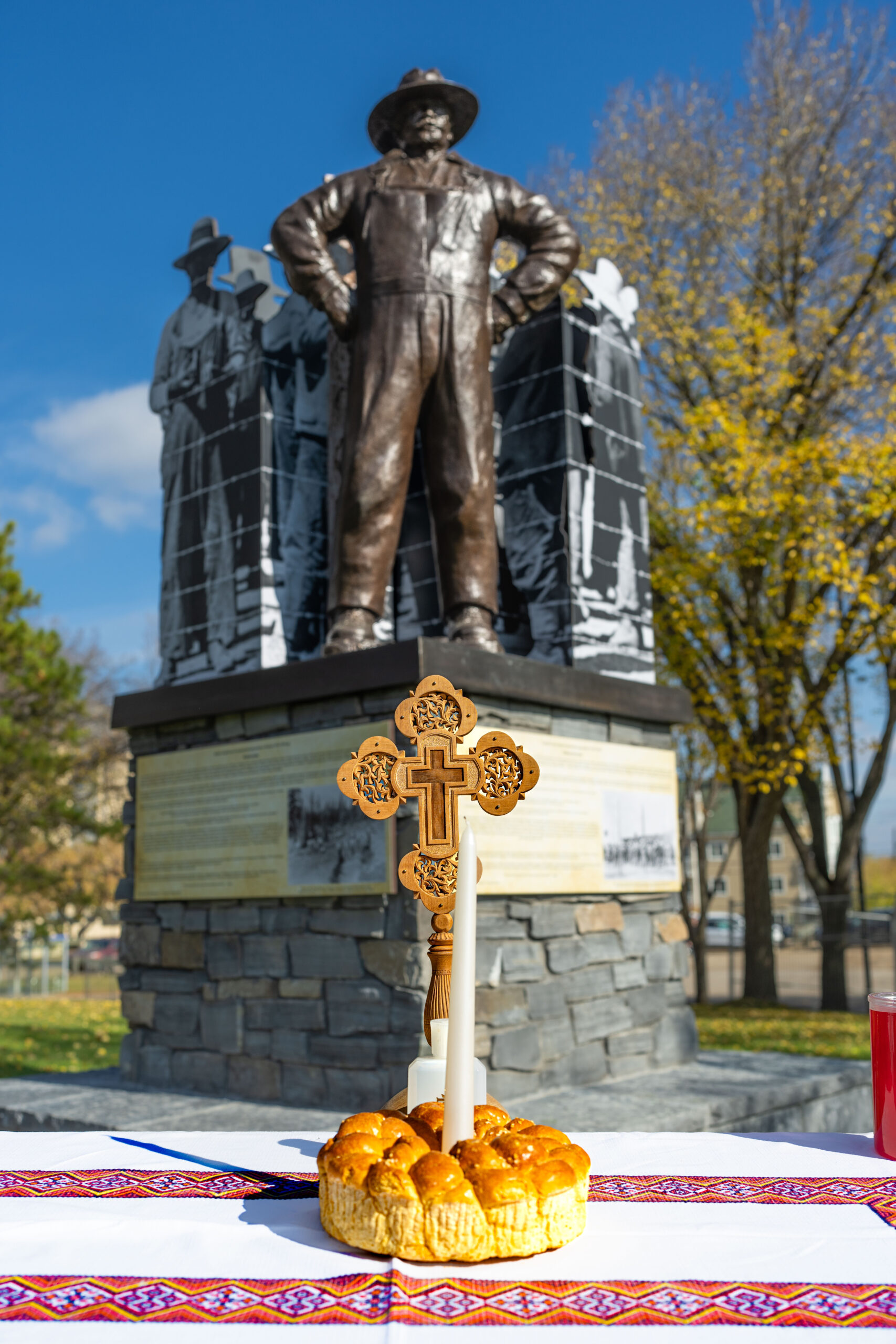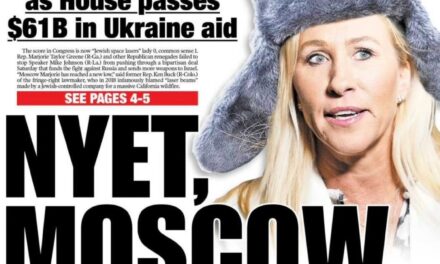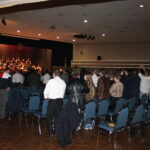Marco Levytsky, NP-UN Western Bureau Chief.
Approximately 250 people attended the unveiling of a monument to victims of Canada’s First National Internment Operations of 1914-1920 at the Alberta Legislature Grounds in Edmonton, October 1.
During that period, 8,579 men, and some women and children, were interned by the Canadian government acting under the authority of the War Measures Act. Most of them came from the western Ukrainian regions of Halychyna (Galicia), Bukovyna and Zakarpatia.

The Internment Monument. Photo: Marco Levytsky
“Held in 24 receiving stations and Internment camps across the country — from Nanaimo, BC to Halifax, NS — these ‘second class’ prisoners of war (POWs) were generally separated from ‘first class’ German and Austrian POWs. Many were transported into the country’s frontier wildernesses and obliged to work for the profit of their jailers. Personal wealth and property were confiscated, not all of which was returned on parole or following the end of the internment operations,” said Borys Sydoruk, Chairman of the Ukrainian Canadian Civil Liberties Foundation (UCCLF) which initiated and carried out the project in cooperation with the Alberta Ministry of Infrastructure.
Sydoruk noted that Canada’s first national internment operations “were shaped by pre-war prejudices that were exacerbated by wartime xenophobia.”
He cited a clergyman of the time, Father Moris, stated that “Galicians “are, from the point of view of civilization, 10 times lower than the Indians. They have not the least idea of sanitation. In their personal habits and acts [they] resemble animals, and even in the streets of Edmonton, when they come to market, men, women, and children, would, if unchecked, turn the place into a common sewer.”
In total, 107 internees died in captivity, six shot dead while attempting to escape, others succumbing to infectious diseases, work-related injuries and suicide.
Despite the end of the war on November 11, 1918, the Internment Operations Branch, commanded by Sir William Dillon Otter, remained active until June 20, 1920.
Speaking on behalf of the Ukrainian Canadian Foundation of Taras Shevchenko, one of the major donors to this project First Vice-President, Oryssia Lennie said that since 1985, the Ukrainian Canadian community, worked tirelessly for official acknowledgement of this injustice.
“In 2008, the Federal Government of Canada established a $10 million endowment known as the “Canadian First World War Internment Recognition Fund” to commemorate and educate Canadians about Canada’s first national internment operations.
“Since inception, the Recognition Fund has awarded close to 5 million dollars in grants in support of a wide range of projects. These include historical exhibits, books, films, internee cemeteries, historical research, artistic endeavours, virtual and augmented reality projects, educational resources, and commemorative plaques and monuments such as the one we stand before today,” said Lennie.
Speaking on behalf of the Ukrainian Canadian Committee – Alberta Provicial Council, Director Liliya Sokha said the monument “stands as a testament of resilience, strength and enduring spirit of Ukrainian Canadians who endured a terrible injustice during World War I.”
“We come together to honor those who suffered in one of the darkest chapters in Canadian history… And even today, while fighting against Russia, Ukrainians have given the world a chance to see what Ukrainian bravery is. Ukrainians have become the bravest nation in the world. And in Canada, we commit ourselves to building a more inclusive and tolerant society that values diversity and embraces the contributions of all its members,” she added.
Former Justice and Health Minister Tyler Shandro said bringing the project to fruition took many years and commended the UCCLC “for their indominable spirit in being able to continue to advocate for this monument”.
He noted that there have been many monuments erected at the internment sites, but few Canadians get to see them which is why it was important to have one at the Legislature.
For many years there have been monuments erected at the sites of these operations, but few Canadians get to see them which is why it was so important to have.
“There are so many Canadians that – to this day – still don’t know,” said Shandro, adding that it is important to educate Canadians “to learn from this and make sure that it never happens again.”
Representing the Provincial Government Jackie Armstrong-Homeniuk, Fort Saskatchewan-Vegreville and Parliamentary Secretary for Settlement Services and Ukrainian Evacuees, stated: “Over a century after the World War 1 internment camps closed, our province takes a step forward in educating Albertans about this black spot in our past, and commemorating those that suffered through the internment camps, as we work together to build a better future for all Albertans.”
“As a descendant myself of one of the first Ukrainian settlers in Alberta, it is particularly meaningful for me to be able to participate today as we commemorate those who lost so much,” she added.
The monument was consecrated by Very Reverend Cornell Zubritsky of the Ukrainian Orthodox Church of Canada, Reverend Julian Bilyj of the Ukrainian Catholic Eparchy of Edmonton, and Reverend Slavko Dumec, also of the Ukrainian Catholic Eparchy of Edmonton.
Responses were sung by the Axios Men’s Ensemble, under the directorship of Deacon Micah Friesen, to sing the response.
Wreaths were laid by representatives of The Ukrainian Canadian Foundation of Taras Shevchenko; The Ukrainian Canadian Congress Alberta Provincial Council; The League of Ukrainian Canadians, Edmonton; The St John’s Legacy Foundation, Edmonton; The Ukrainian Catholic Brotherhood of Canada, Alberta Branch; The Ukrainian Women’s Association of Canada, Olga Basarab Branch, Calgary; The Ukrainian Youth Association of Canada (CYM), Edmonton Branch and The Ukrainian Canadian Civil Liberties Foundation.
“These organizations – together with Plast Ukrainian Youth Association of Canada (Calgary), the SUS Foundation of Canada, the Ukrainian Canadian Benevolent Society of Edmonton, the Ukrainian Pioneers Association of Alberta, the Edmonton and Calgary Branches of the Ukrainian Self-Reliance Association of Edmonton – are acknowledged on the donor board. These organizations were the donors to this project. It is through their crucial financial contributions that this project was made possible. The project was, therefore, completed without any taxpayer dollars,” said MC Andriy Harasymiw.
Titled Endurance, the monument was designed and sculpted by St. Paul, Alta. artist Herman Poulin.
Share on Social Media





































